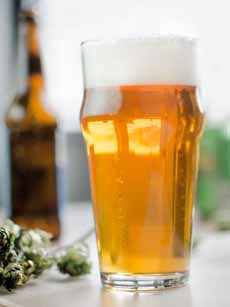Beer 101: What Are Hops, For National Beer Day
|
Hops are one of the four components of beer, along with malted barley, yeast and water. They are used primarily as bittering, flavoring, and stability agents. In addition to bitterness, they impart floral, fruity, or citrus flavors and aromas, based on the particular strain and the terroir*. Without hops, beer would be a sticky-sweet fermented barley drink—unattractive, says a source. Hops (Humulus lupulus) are climbing plants, much like grape vines (photo #2). Without hop flowers (photo #1), there would be no beer as we know it. The first documentation of hop cultivation of hops is from 736, in Bavaria. But they are are not mentioned as a bittering agent for beer for three more centuries, until 1079. Prior to then, brewers used a variety of bitter herbs and other plants to impart bitterness: bog myrtle, borage, heather, spruce tips. Hops were then used medicinally and to impart bitterness to other beverages. In the Middle Ages, brewers flavored their beer with a mixture called gruit, that combined bitter herbs, spices and flowers: burdock root, dandelion, heather, horehound, ivy and marigold. Early documents mention a hop garden in his will; although at that time, hops were used to flavor other beverages, and for medicinal purposes (source). In the 11th century some creative brewer, to whom all beer drinkers are indebted, decided to use hops in the brew. But not until the 13th century did hops begin to edge out the use of gruit in brewing. Hops Beyond Germany Hop cultivation spread to other parts of Europe, and experimentation began to improve the quality of hop flavor. Beer was an essential part of the daily diet for both adults and children (water supplies were unreliable and often tainted). Hops came to America in 1629, and were grown by English and Dutch farmers. After then, there was not much of note to consumers in hops, which were used by what had become large breweries. But with the growth of microbreweries in the U.S., beginning on the West Coast in the 1980s, small-batch brewers discovered how different hops created different flavors and aromas in their beers. Hops began to move “from their position as the supporting actor in the beer ensemble to the starring role” (source). |
|
|
|
Today, craft brewers are so focused on the flavors yielded by hops from different terroirs* that they test a variety on new brews until they find what they’re looking for, and work to develop new strains that yield the characteristics they seek. Rogue Ales in Oregon, for example, one of America’s first microbreweries, grows 10 varieties of our proprietary hops. Some breweries grow their own hops, but most work with hop farmers to grow what they need. It’s no surprise that the global production of hops has risen, and more land is devoted to growing them (source). Here are some of the different types of hops grown in the U.S. You’ve been a good student, learning the history of hops and the part they play in brewing. You are now entitled to enjoy a cold one. *Terroir, pronounced tur-WAH, is the French word for soil, land or terrain. It can be loosely translated as “a sense of place,”the sum of the effects that the environment has on the creation of what is grown there. It has long been used in wine and coffee analysis to denote the special characteristics of soil, climate, weather, geology, aspect (how many hours it gets direct sunlight, e.g.) and altitude that give the grape or bean its individuality. The term is now being used, appropriately, to describe other agricultural products.
|
||





